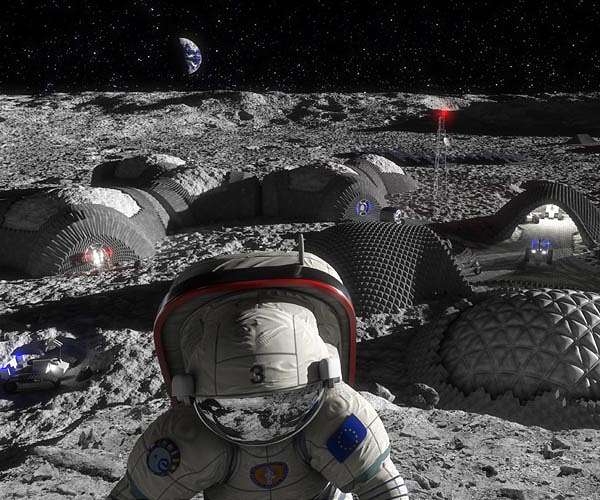
Astroport Space Technologies awarded 2nd NASA for lunar construction (Image Credit: Space Daily)
Astroport Space Technologies, Inc. has been awarded its second NASA Phase 1 Small Business Technology Transfer (STTR) contract for the construction of landing pads on the Moon.
Astroport and its research partner, The University of Texas at San Antonio (UTSA), will develop geotechnical engineering processes for “Lunar Surface Site Preparation for Landing/Launch Pad and Blast Shield Construction” with a focus on “regolith works” for bulk regolith excavation and movement. The project will build on Astroport’s previous Phase 1 STTR-21 work on regolith melting technologies and robotic bricklaying system for lunar infrastructure construction.
The new research will describe a multi-step Concept of Operations (CONOPS) for “regolith works” executed by multiple machines operating autonomously or in remote control mode with step sequencing/timing to enable machine-to-machine collaboration. In particular, it will define conveyance techniques and sorting and filtering processes to prepare and deliver excavated regolith to Astroport’s Lunatron bricklayer system.
The project will utilize space civil engineering expertise from the University of Adelaide’s Andy Thomas Centre for Space Resources (ATCSR) in Australia. Venturi Astrolab of Hawthorne, CA, will provide consulting support for integration into the overall system architecture of their FLEX rover as a baseline robotic mobility platform operating a suite of excavation tools.
Astroport’s Founder/CEO and Space Architect, Sam Ximenes said, “we are pleased that NASA continues to place confidence in our team’s ability to define and develop technologies and processes for lunar infrastructure construction. Under this new contract, the Astroport team will continue its work on the overall construction system architecture that we have started last year. Our objectives are to advance the state-of-art with geotechnical engineering and civil engineering processes for bulk regolith manipulation using a “regolith works” toolset for preparation of the lunar launch/landing site”.
Principal investigator for UTSA, Dr. Sazzad Bin-Shafique, said “this research is a natural progression of the University’s regolith liquefaction investigations, in that the Phase 1 study will develop discreet-event modeling of the bulk regolith conveyance methods to help determine feeds rates for Astroport’s Lunatron bricklayer system.” UTSA co-principal investigator, Dr. Ibukun Awolusi, assistant professor of construction science and management stated that “leveraging innovative technologies and systems such as those proposed in this study offers remarkable opportunities for the use of lunar materials, construction processes, and our efforts toward achieving space sustainability.”
ATCSR is one of a handful of organizations globally that has focused on the development of “space civil engineering” processes for planetary construction. ATCSR has developed numerical modeling to represent the geotechnical behavior of the natural lunar regolith when subjected to load in a lunar environment. This numerical representation facilitates the modeling of a range of lunar construction activities, such as vehicular movement, excavation, and compaction.
John Culton, Director of the Andy Thomas Centre for Space Resources at the University of Adelaide said, “ATCSR is proud to support cutting-edge US partners leading the development of critical off-Earth civil engineering processes required to return humans to the Moon, ‘this time to stay'”.
Related Links
Astroport Space Technologies
Mars News and Information at MarsDaily.com
Lunar Dreams and more
|
|
Tweet |
|
|
|
We need your help. The SpaceDaily news network continues to grow but revenues have never been harder to maintain. With the rise of Ad Blockers, and Facebook – our traditional revenue sources via quality network advertising continues to decline. And unlike so many other news sites, we don’t have a paywall – with those annoying usernames and passwords. Our news coverage takes time and effort to publish 365 days a year. If you find our news sites informative and useful then please consider becoming a regular supporter or for now make a one off contribution. |
||
|
SpaceDaily Contributor $5 Billed Once credit card or paypal |
SpaceDaily Monthly Supporter $5 Billed Monthly paypal only |
|
South Korea’s first lunar orbiter launched by SpaceX
Seoul (AFP) Aug 5, 2022
South Korea’s first lunar orbiter successfully launched on a year-long mission to observe the Moon, Seoul said Friday, with the payload including a new disruption-tolerant network for sending data from space.
Danuri – a portmanteau of the Korean words for “Moon” and “enjoy” – was on a Falcon 9 rocket launched from Cape Canaveral in Florida by Elon Musk’s aerospace company SpaceX. It aims to reach the Moon by mid-December.
“South Korea’s first lunar orbiter ‘Danuri’ left for space at 8:08 am on … read more









